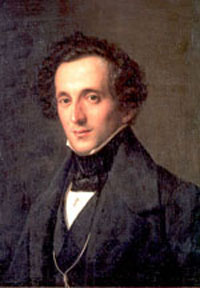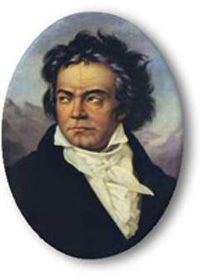| Beethoven's Eroica | ||||||||||
Lyric for Strings Composer, pianist and educator George Walker has achieved an important series of African American “firsts” in his long career: Graduate of Oberlin College Conservatory, the Curtis Institute, Doctor of Musical Arts from Eastman – and the first black composer to study with Nadia Boulanger in Paris. He was the first black instrumentalist to appear with the Philadelphia Orchestra, playing Rachmaninov’s Piano Concerto No. 3, and the first African American composer to receive a Pulitzer Prize (1996). His autobiography, Reminiscences of an American Composer and Pianist, was published in 2009. Walker has spent most of his professional life teaching at music departments around the country, including Smith College, Colorado University, Rutgers University and the Peabody Institute of Johns Hopkins University; he also toured extensively as pianist in Europe. Walker is an unashamed neo-romantic, having lived nearly a century that saw countless developments in musical style from Schoenberg to Cage – and back. He is a prolific composer, whose works are reminiscent of those of Samuel Barber. The Lyric for Strings originated from the second movement of Walker's String Quartet No. 1, composed in 1945. In a certain sense, it is a doppelgänger of Barber’s Adagio for Strings, which was also extracted from a string quartet. Both works are tonal and spin out a single melody in free variation.  Walker sometimes submerges his theme, or parts of it, in internal voices, but it is always there, as in this major iteration. Walker sometimes submerges his theme, or parts of it, in internal voices, but it is always there, as in this major iteration.  | ||||||||||
Piano Concerto No. 1 in G minor, Op. 25 Scion of a great banking family, Felix Mendelssohn had no need for the revenue from publishing his compositions, and published only what he considered mature and worthy. In fact, all of his works from opus 73 onward – including the Italian and Reformation symphonies, were published posthumously. Quite a contrast with his older contemporary, Beethoven, who spent considerable energy wheeling, dealing and even double-dealing to wring every extra Thaler out of prospective publishers. And then, of course there was the impecunious Mozart. In June 1830, on his way to Italy, Mendelssohn stopped in Munich, where he met one of the local beauties, the seventeen-year-old gifted pianist Delphine von Schauroth. A romance developed, urged on by Bavaria’s king Ludwig I, but Mendelssohn was annoyed because at 22 he had no intention of settling down. While in Italy he sketched out the Piano Concerto in G minor, finishing it in Munich the following year on his return trip. He dedicated it to Delphine and premiered it immediately at a benefit concert for Munich’s poor. He delighted in the superb playing of the orchestra and in the enthusiastic reception of the new concerto. Its popularity spread quickly through the championship of virtuoso pianist Clara Schumann, Robert Schumann’s wife, and Franz Liszt. The first movement is characterized by quintessential Romantic storminess. In an unusual move for a concerto’s first movement, the soloist crashes in with a musical tantrum, replete with flamboyantly rapid flourishes and arpeggios.  The piano and orchestra responds with an equally angry first theme. The piano and orchestra responds with an equally angry first theme.  Even the obligatory contrasting second theme alternates between lyrical, optimistic melody and passages in darker harmonies. Even the obligatory contrasting second theme alternates between lyrical, optimistic melody and passages in darker harmonies.  The second movement is in the distant key of E major, its gentle melody harking back to the style of Beethoven.  In rather flexible structure suggests a reverie, including troubling memories, with refrain-like returns to romantic nostalgia. In rather flexible structure suggests a reverie, including troubling memories, with refrain-like returns to romantic nostalgia.  The orchestral introduction of the Finale hints at more storm clouds to come,  but the piano finally enters in a resounding G major, and the movement continues in a mood of uninterrupted celebration. but the piano finally enters in a resounding G major, and the movement continues in a mood of uninterrupted celebration.  The following runs and flourishes now take on a sense of joy and playfulness. The following runs and flourishes now take on a sense of joy and playfulness.  The overall effect of the Concerto is of a tense drama bordering on tragedy finally triumphantly resolved by means of a tender intervention. And although the Concerto is in G minor only the first movement is in that key. Mendelssohn often created a dramatic narrative within the context of “absolute” music. The overall effect of the Concerto is of a tense drama bordering on tragedy finally triumphantly resolved by means of a tender intervention. And although the Concerto is in G minor only the first movement is in that key. Mendelssohn often created a dramatic narrative within the context of “absolute” music.Mendelssohn was a phenomenal pianist, as attested by none other than composer, music critic and acerbic commentator Héctor Berlioz who wrote of him: “His performing talent is as great as his musical genius, which is really saying a great deal.” Berlioz, incidentally, attached a program to all of his works. As a mature artist, Mendelssohn was acclaimed throughout Europe as pianist, composer and conductor, especially in his native Germany and England. His untimely death from unknown causes created a profound shock, and Mendelssohn societies quickly sprang up. | ||||||||||
Symphony No. 3 in E-flat major, Op. 55, “Eroica” Few musical manuscripts have elicited so much musicological discussion as has Beethoven’s personal conductor’s copy of his Symphony No. 3. The story of its original dedication to Napoleon, the chief military defender of the French Revolution with its ideals of Liberty, Equality and Fraternity, and the subsequent violent erasure of the dedication when Napoleon crowned himself emperor, has been told time and again. Reality, however, is often more complex than history books would make it appear. Beethoven was clearly disgusted at Napoleon’s coronation, exclaiming: “Is he then, too, nothing more than an ordinary human being? Now he, too, will trample on all the rights of man...become a tyrant.” But his disappointment was tinged in no small part by self-interest. Hoping at the time to establish a foothold in the musical life of Paris, the composer had planned to travel there with his mentor, Prince Lobkowitz, using the premiere of the Symphony as a passport to the French capital. Napoleon’s coup, and the resultant political upheavals, disrupted these plans and are the probable reason why the Symphony, finished at the beginning of 1804, did not receive its premiere in Vienna until a year later. One of the most fascinating aspects of the Symphony is how Beethoven – who had surprising difficulty coming up with melodies – was able to make so much out of so little. The opening theme is nothing more than an arpeggiated e-flat major chord; the Scherzo theme is a descending E-flat major chord; the Scherzo theme is a descending E-flat major scale; and the theme for the Finale is a simple bass pattern that he had used three times previously – in the Piano Variations, Op. 35, in one of his Contredanses (WoO 14, no. 7) and in the grand finale of his ballet The Creatures of Prometheus, Op. 43 – repeated beneath a set of spectacular variations. Only the second movement, the Funeral March, begins with a fully formed theme. It is hard for us today to appreciate the revolutionary impact of this symphony on Vienna’s audience. The constantly modulating keys, rhythmic shifts, large dynamic leaps and unfamiliar harmonies baffled Beethoven’s friendly but conservative public, and the reception was anything but enthusiastic. It took a few years for the Viennese to warm to this innovative work. Although it would take many pages of in-depth musical analysis to explain what was so different and disturbing about this Symphony, here are some highlights that we now take for granted after over 200 years of development and change in Western music. To begin with, there is the sheer length and scope of the work. The first movement alone is longer than anything that had been written up to this time. And then there's Beethoven's treatment of themes. The opening of the Symphony contains as its first theme that simple E-flat major arpeggio, but appended to it one note that propels it into greatness.  What follows is a complex and, at times, astonishing key structure, whose wanderings and surprises blur the distinctions between the parts of sonata form. The movement contains no less than seven themes (some people count more). Here are the ones that Beethoven later develops. What follows is a complex and, at times, astonishing key structure, whose wanderings and surprises blur the distinctions between the parts of sonata form. The movement contains no less than seven themes (some people count more). Here are the ones that Beethoven later develops.  & &  The development section, however, introduces an entirely new theme in the minor mode that never appeared in the exposition. The development section, however, introduces an entirely new theme in the minor mode that never appeared in the exposition.  Even though the theme is short, the change in mode is particularly stunning in view of the overwhelming number of major themes in the exposition. The movement's most significant surprise, however, is the appearance of the three-minute coda in a distant key. Even though the theme is short, the change in mode is particularly stunning in view of the overwhelming number of major themes in the exposition. The movement's most significant surprise, however, is the appearance of the three-minute coda in a distant key.  The Andante, entitled “Funeral March for a Hero,” counters even the most poignant Mozartian second movement with a totally novel level of emotional intensity and grandeur.  Its middle section transcends tragedy to arrive at the triumph that gives the Symphony its moniker. Its middle section transcends tragedy to arrive at the triumph that gives the Symphony its moniker.  The Scherzo – an earlier Beethoven invention to replace the sometimes stately, sometimes thumping minuets of Mozart and Haydn – consists of a theme that is nothing more than a slightly decorated descending major scale. The Scherzo – an earlier Beethoven invention to replace the sometimes stately, sometimes thumping minuets of Mozart and Haydn – consists of a theme that is nothing more than a slightly decorated descending major scale.  Its trio scored for a sections solo for the horns. Its trio scored for a sections solo for the horns.  Instead of creating a sprightly and upbeat rondo in the style of his predecessors, Beethoven gives a weight and importance to the Finale that would inspire both his own future symphonic writing (culminating in the Ninth Symphony) and that of his successors. The theme is nothing more then a skeleton, actually more a ground bass than a true melody.  The variations that constitute this lengthy movement are also new in structure. Whereas most sets of variations move steadily from the simple to the complex, Beethoven was less interested in bravura and ornamentation than in giving each variation its own mood, for which he also employed an innovative use of orchestral solos and ensembles. The first few variations are conventional, reinforcing the theme. The variations that constitute this lengthy movement are also new in structure. Whereas most sets of variations move steadily from the simple to the complex, Beethoven was less interested in bravura and ornamentation than in giving each variation its own mood, for which he also employed an innovative use of orchestral solos and ensembles. The first few variations are conventional, reinforcing the theme.  Then Beethoven relegates the theme to the bass, where it really belongs, the oboe melody over it sounding more like a true theme. Then Beethoven relegates the theme to the bass, where it really belongs, the oboe melody over it sounding more like a true theme.  In fact, this was the theme Beethoven reused in The Creatures of Prometheus, mentioned above. While variation forms had tended to be somewhat static, adhering throughout to a single key and the same length as the theme, Beethoven includes variations in different keys and lengths, for example, this little fugue. In fact, this was the theme Beethoven reused in The Creatures of Prometheus, mentioned above. While variation forms had tended to be somewhat static, adhering throughout to a single key and the same length as the theme, Beethoven includes variations in different keys and lengths, for example, this little fugue.  He even breaks away from the variations altogether in the middle of the movement. He even breaks away from the variations altogether in the middle of the movement.  Most important, however, is that the climax of the movement is not created by means of faster and faster demonstrations of technical virtuosity, but rather through increasing emotional intensity and grandeur. Most important, however, is that the climax of the movement is not created by means of faster and faster demonstrations of technical virtuosity, but rather through increasing emotional intensity and grandeur. | ||||||||||
| Copyright © Elizabeth and Joseph Kahn 2017 | ||||||||||


